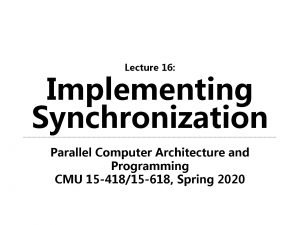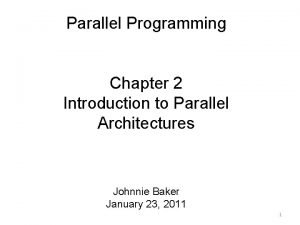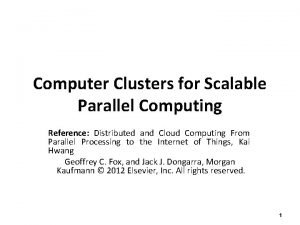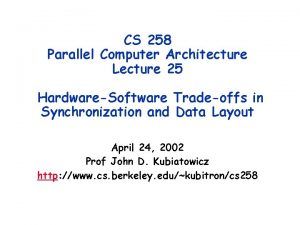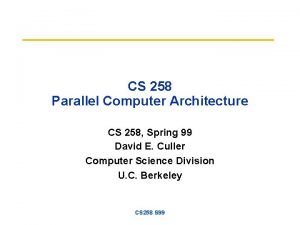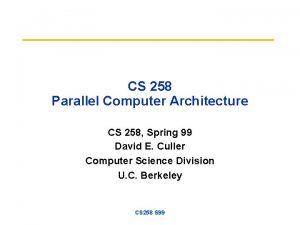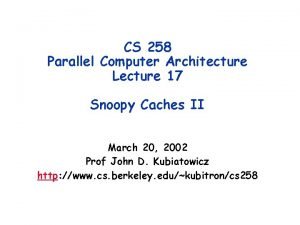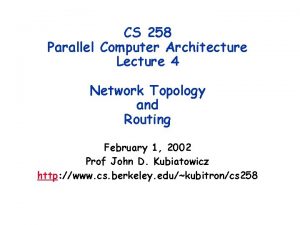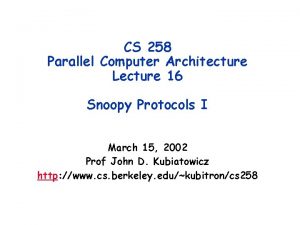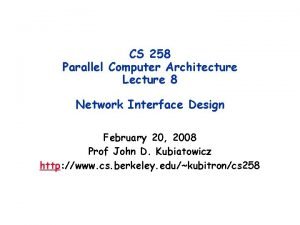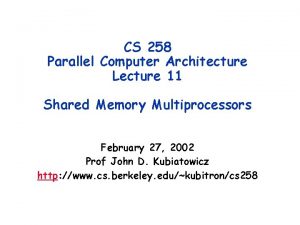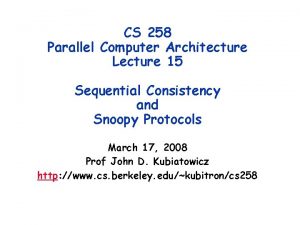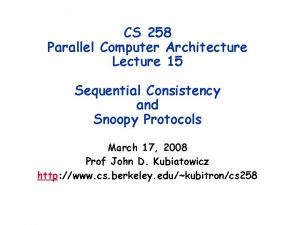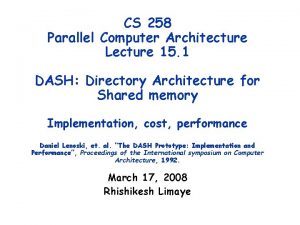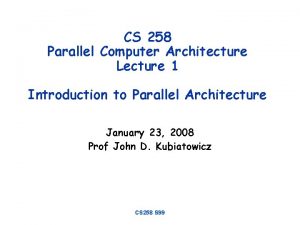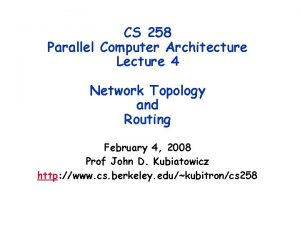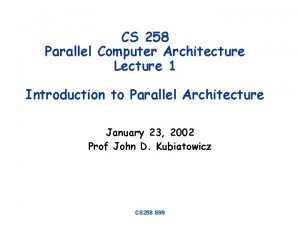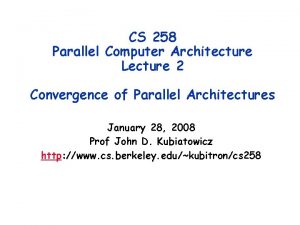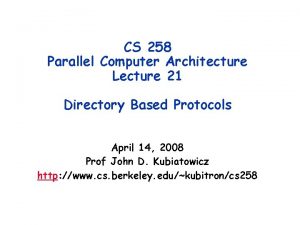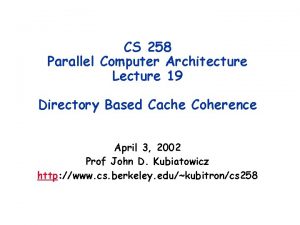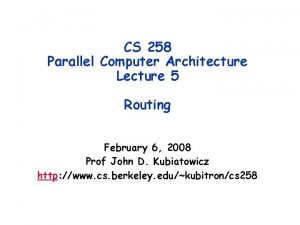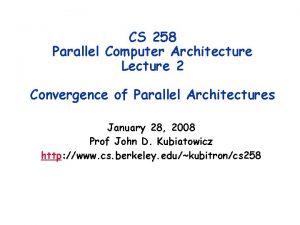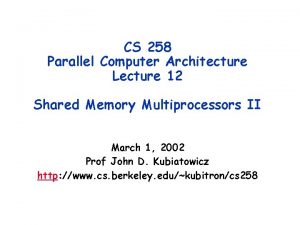CS 258 Parallel Computer Architecture Lecture 23 HardwareSoftware






























- Slides: 30

CS 258 Parallel Computer Architecture Lecture 23 Hardware-Software Trade-offs in Synchronization and Data Layout April 21, 2002 Prof John D. Kubiatowicz http: //www. cs. berkeley. edu/~kubitron/cs 258

Role of Synchronization • “A parallel computer is a collection of processing elements that cooperate and communicate to solve large problems fast. ” • Types of Synchronization – Mutual Exclusion – Event synchronization » point-to-point » group » global (barriers) • How much hardware support? – high-level operations? – atomic instructions? – specialized interconnect? 4/21/08 Kubiatowicz CS 258 ©UCB Spring 2008 Lec 23. 2

Components of a Synchronization Event • Acquire method – Acquire right to the synch » enter critical section, go past event • Waiting algorithm – Wait for synch to become available when it isn’t – busy-waiting, blocking, or hybrid • Release method – Enable other processors to acquire right to the synch • Waiting algorithm is independent of type of synchronization – makes no sense to put in hardware 4/21/08 Kubiatowicz CS 258 ©UCB Spring 2008 Lec 23. 3

Strawman Lock Busy-Wait lock: ld cmp bnz st ret unlock: st register, location, lock /* location, /* location /* copy location to register */ #0 /* compare with 0 */ if not 0, try again */ #1 /* store 1 to mark it locked */ return control to caller */ location, #0 /* write 0 to location */ /* return control to caller */ Why doesn’t the acquire method work? Release method? 4/21/08 Kubiatowicz CS 258 ©UCB Spring 2008 Lec 23. 4

What to do if only load and store? • Here is a possible two-thread solution: Thread A Thread B Set A=1; Set B=1; while (B) {//X if (!A) {//Y do nothing; Critical Section; } } Critical Section; Set B=0; Set A=0; • Does this work? Yes. Both can guarantee that: – Only one will enter critical section at a time. • At X: – if B=0, safe for A to perform critical section, – otherwise wait to find out what will happen • At Y: – if A=0, safe for B to perform critical section. – Otherwise, A is in critical section or waiting for B to quit • But: – Really messy – Generalization gets worse 4/21/08 Kubiatowicz CS 258 ©UCB Spring 2008 Lec 23. 5

Atomic Instructions • Specifies a location, register, & atomic operation – Value in location read into a register – Another value (function of value read or not) stored into location • Many variants – Varying degrees of flexibility in second part • Simple example: test&set – – 4/21/08 Value in location read into a specified register Constant 1 stored into location Successful if value loaded into register is 0 Other constants could be used instead of 1 and 0 Kubiatowicz CS 258 ©UCB Spring 2008 Lec 23. 6

Zoo of hardware primitives • test&set (&address) { /* most architectures */ result = M[address]; M[address] = 1; return result; } • swap (&address, register) { /* x 86 */ temp = M[address]; M[address] = register; register = temp; } • compare&swap (&address, reg 1, reg 2) { /* 68000 */ if (reg 1 == M[address]) { M[address] = reg 2; return success; } else { return failure; } } • load-linked&store conditional(&address) { /* R 4000, alpha */ loop: ll r 1, M[address]; movi r 2, 1; /* Can do arbitrary comp */ sc r 2, M[address]; beqz r 2, loop; } 4/21/08 Kubiatowicz CS 258 ©UCB Spring 2008 Lec 23. 7

Mini-Instruction Set debate • atomic read-modify-write instructions – IBM 370: included atomic compare&swap for multiprogramming – x 86: any instruction can be prefixed with a lock modifier – High-level language advocates want hardware locks/barriers » but it’s goes against the “RISC” flow, and has other problems – SPARC: atomic register-memory ops (swap, compare&swap) – MIPS, IBM Power: no atomic operations but pair of instructions » load-locked, store-conditional » later used by Power. PC and DEC Alpha too – 68000: CCS: Compare and compare and swap » No-one does this any more • Rich set of tradeoffs 4/21/08 Kubiatowicz CS 258 ©UCB Spring 2008 Lec 23. 8

Other forms of hardware support • • • 4/21/08 Separate lock lines on the bus Lock locations in memory Lock registers (Cray Xmp) Hardware full/empty bits (Tera) QOLB (machines supporting SCI protocol) Bus support for interrupt dispatch Kubiatowicz CS 258 ©UCB Spring 2008 Lec 23. 9

Simple Test&Set Lock lock: t&s bnz ret unlock: ret register, location lock /* if not 0, try again */ /* return control to caller */ st location, #0 /* write 0 to location */ /* return control to caller */ • Other read-modify-write primitives – Swap – Fetch&op – Compare&swap » Three operands: location, register to compare with, register to swap with » Not commonly supported by RISC instruction sets • cacheable or uncacheable 4/21/08 Kubiatowicz CS 258 ©UCB Spring 2008 Lec 23. 10

Performance Criteria for Synch. Ops • Latency (time per op) – especially when light contention • Bandwidth (ops per sec) – especially under high contention • Traffic – load on critical resources – especially on failures under contention • Storage • Fairness 4/21/08 Kubiatowicz CS 258 ©UCB Spring 2008 Lec 23. 11

T&S Lock Microbenchmark: SGI Chal. 20 s 18 16 l n u s s 14 Time ( s) l s Test&set, c = 0 Test&set, exponential backof f, c = 3. 64 Test&set, exponential backof f, c = 0 Ideal l s s 12 l s s s 10 s l n 8 l 6 l n s l l n n lock; delay(c); unlock; n n l n 4 s l 2 sn l 0 u l n n l s uuuuuuuu l n n n 3 5 7 9 11 13 15 Number of processors • Why does performance degrade? • Bus Transactions on T&S? • Hardware support in CC protocol? 4/21/08 Kubiatowicz CS 258 ©UCB Spring 2008 Lec 23. 12

Enhancements to Simple Lock • Reduce frequency of issuing test&sets while waiting – Test&set lock with backoff – Don’t back off too much or will be backed off when lock becomes free – Exponential backoff works quite well empirically: ith time = k*ci • Busy-wait with read operations rather than test&set – Test-and-test&set lock – Keep testing with ordinary load » cached lock variable will be invalidated when release occurs – When value changes (to 0), try to obtain lock with test&set » only one attemptor will succeed; others will fail and start testing again 4/21/08 Kubiatowicz CS 258 ©UCB Spring 2008 Lec 23. 13

Busy-wait vs Blocking • Busy-wait: I. e. spin lock – Keep trying to acquire lock until read – Very low latency/processor overhead! – Very high system overhead! » Causing stress on network while spinning » Processor is not doing anything else useful • Blocking: – If can’t acquire lock, deschedule process (I. e. unload state) – Higher latency/processor overhead (1000 s of cycles? ) » Takes time to unload/restart task » Notification mechanism needed – Low system overheadd » No stress on network » Processor does something useful • Hybrid: – Spin for a while, then block – 2 -competitive: spin until have waited blocking time 4/21/08 Kubiatowicz CS 258 ©UCB Spring 2008 Lec 23. 14

Improved Hardware Primitives: LL-SC • Goals: – Test with reads – Failed read-modify-write attempts don’t generate invalidations – Nice if single primitive can implement range of r-m-w operations • Load-Locked (or -linked), Store-Conditional – – LL reads variable into register Follow with arbitrary instructions to manipulate its value SC tries to store back to location succeed if and only if no other write to the variable since this processor’s LL » indicated by condition codes; • If SC succeeds, all three steps happened atomically • If fails, doesn’t write or generate invalidations – must retry aquire 4/21/08 Kubiatowicz CS 258 ©UCB Spring 2008 Lec 23. 15

Simple Lock with LL-SC lock: unlock: ll sc beqz ret st reg 1, location, reg 2, lock /* LL location to reg 1 */ /* SC reg 2 into location*/ /* if failed, start again */ location, #0 /* write 0 to location */ • Can do more fancy atomic ops by changing what’s between LL & SC – But keep it small so SC likely to succeed – Don’t include instructions that would need to be undone (e. g. stores) • SC can fail (without putting transaction on bus) if: – Detects intervening write even before trying to get bus – Tries to get bus but another processor’s SC gets bus first • LL, SC are not lock, unlock respectively – Only guarantee no conflicting write to lock variable between them – But can use directly to implement simple operations on shared variables 4/21/08 Kubiatowicz CS 258 ©UCB Spring 2008 Lec 23. 16

Trade-offs So Far • • • Latency? Bandwidth? Traffic? Storage? Fairness? • What happens when several processors spinning on lock and it is released? – traffic per P lock operations? 4/21/08 Kubiatowicz CS 258 ©UCB Spring 2008 Lec 23. 17

Ticket Lock • Only one r-m-w per acquire • Two counters per lock (next_ticket, now_serving) – Acquire: fetch&inc next_ticket; wait for now_serving == next_ticket » atomic op when arrive at lock, not when it’s free (so less contention) – Release: increment now-serving • Performance – low latency for low-contention - if fetch&inc cacheable – O(p) read misses at release, since all spin on same variable – FIFO order » like simple LL-SC lock, but no inval when SC succeeds, and fair – Backoff? • Wouldn’t it be nice to poll different locations. . . 4/21/08 Kubiatowicz CS 258 ©UCB Spring 2008 Lec 23. 18

Array-based Queuing Locks • Waiting processes poll on different locations in an array of size p – Acquire » fetch&inc to obtain address on which to spin (next array element) » ensure that these addresses are in different cache lines or memories – Release » set next location in array, thus waking up process spinning on it – O(1) traffic per acquire with coherent caches – FIFO ordering, as in ticket lock, but, O(p) space per lock – Not so great for non-cache-coherent machines with distributed memory » array location I spin on not necessarily in my local memory (solution later) 4/21/08 Kubiatowicz CS 258 ©UCB Spring 2008 Lec 23. 19

Lock Performance on SGI Challenge Array- bas ed 6 LL-SC n LL-SC, u Ticket s Ticket, 6 u u u u u 5 u l l u l sl l s s 6 s s s s 4 3 6 6 2 0 6 6 6 n su 6 u n l n s 6 n n sl n u 6 n n n 3 5 7 9 Number of processors (a) Null (c = 0, d = 0) l u 3 13 15 1 6 u u u l s sl l 6 l l s 6 s s 6 6 l s s 7 u 6 9 11 15 3 u 6 6 1 s l n u 6 1 Number of processors (b) Critical-section (c = 3. 64 s, d = 0) u u u l 6 6 l l 6 6 6 l l u l l l 6 u l l s l su u 6 s s 6 s n s s s 6 u s sn s s s n n 6 n n n n n 2 13 u l 4 0 5 u u l n 6 6 6 n n n n n n 3 u 5 6 s l n u 6 7 u u 2 1 11 u u l l l u u sl l sl s u su s s s 4 0 1 4/21/08 6 6 n n Time ( s) 5 1 proportional 7 u Loop: lock; delay(c); unlock; delay(d); ex pon ent ial Time ( s) 7 l 3 5 7 9 11 13 15 Number of processors (c) Delay (c = 3. 64 s, d = 1. 29 s) Kubiatowicz CS 258 ©UCB Spring 2008 Lec 23. 20

Point to Point Event Synchronization • Software methods: – Interrupts – Busy-waiting: use ordinary variables as flags – Blocking: use semaphores • Full hardware support: full-empty bit with each word in memory – Set when word is “full” with newly produced data (i. e. when written) – Unset when word is “empty” due to being consumed (i. e. when read) – Natural for word-level producer-consumer synchronization » producer: write if empty, set to full; consumer: read if full; set to empty – Hardware preserves atomicity of bit manipulation with read or write – Problem: flexibility » multiple consumers, or multiple writes before consumer reads? » needs language support to specify when to use » composite data structures? 4/21/08 Kubiatowicz CS 258 ©UCB Spring 2008 Lec 23. 21

Barriers • Software algorithms implemented using locks, flags, counters • Hardware barriers – Wired-AND line separate from address/data bus » Set input high when arrive, wait for output to be high to leave – In practice, multiple wires to allow reuse – Useful when barriers are global and very frequent – Difficult to support arbitrary subset of processors » even harder with multiple processes per processor – Difficult to dynamically change number and identity of participants » e. g. latter due to process migration – Not common today on bus-based machines 4/21/08 Kubiatowicz CS 258 ©UCB Spring 2008 Lec 23. 22

A Simple Centralized Barrier • Shared counter maintains number of processes that have arrived – increment when arrive (lock), check until reaches numprocs – Problem? struct bar_type {int counter; struct lock_type lock; int flag = 0; } bar_name; BARRIER (bar_name, p) { LOCK(bar_name. lock); if (bar_name. counter == 0) bar_name. flag = 0; /* reset flag if first to reach*/ mycount = bar_name. counter++; /* mycount is private */ UNLOCK(bar_name. lock); if (mycount == p) { /* last to arrive */ bar_name. counter = 0; /* reset for next barrier */ bar_name. flag = 1; /* release waiters */ } else while (bar_name. flag == 0) {}; /* busy wait for release */ } 4/21/08 Kubiatowicz CS 258 ©UCB Spring 2008 Lec 23. 23

A Working Centralized Barrier • Consecutively entering the same barrier doesn’t work – Must prevent process from entering until all have left previous instance – Could use another counter, but increases latency and contention • Sense reversal: wait for flag to take different value consecutive times – Toggle this value only when all processes reach BARRIER (bar_name, p) { local_sense = !(local_sense); /* toggle private sense variable */ LOCK(bar_name. lock); mycount = bar_name. counter++; /* mycount is private */ if (bar_name. counter == p) UNLOCK(bar_name. lock); bar_name. flag = local_sense; /* release waiters*/ else { UNLOCK(bar_name. lock); while (bar_name. flag != local_sense) {}; } } 4/21/08 Kubiatowicz CS 258 ©UCB Spring 2008 Lec 23. 24

Centralized Barrier Performance • Latency – Centralized has critical path length at least proportional to p • Traffic – About 3 p bus transactions • Storage Cost – Very low: centralized counter and flag • Fairness – Same processor should not always be last to exit barrier – No such bias in centralized • Key problems for centralized barrier are latency and traffic – Especially with distributed memory, traffic goes to same node 4/21/08 Kubiatowicz CS 258 ©UCB Spring 2008 Lec 23. 25

Improved Barrier Algorithms for a Bus Software combining tree • Only k processors access the same location, where k is degree of tree – – – 4/21/08 Separate arrival and exit trees, and use sense reversal Valuable in distributed network: communicate along different paths On bus, all traffic goes on same bus, and no less total traffic Higher latency (log p steps of work, and O(p) serialized bus xactions) Advantage on bus is use of ordinary reads/writes instead of locks Kubiatowicz CS 258 ©UCB Spring 2008 Lec 23. 26

Barrier Performance on SGI Challenge – Centralized does quite well » Will discuss fancier barrier algorithms for distributed machines – Helpful hardware support: piggybacking of reads misses on bus » Also for spinning on highly contended locks 4/21/08 Kubiatowicz CS 258 ©UCB Spring 2008 Lec 23. 27

Lock-Free Synchronization • What happens if process grabs lock, then goes to sleep? ? ? – Page fault – Processor scheduling – Etc • Lock-free synchronization: – Operations do not require mutual exclusion of multiple insts • Nonblocking: – Some process will complete in a finite amount of time even if other processors halt • Wait-Free (Herlihy): – Every (nonfaulting) process will complete in a finite amount of time • Systems based on LL&SC can implement these 4/21/08 Kubiatowicz CS 258 ©UCB Spring 2008 Lec 23. 28

Using of Compare&Swap for queues • compare&swap (&address, reg 1, reg 2) { /* 68000 */ if (reg 1 == M[address]) { M[address] = reg 2; return success; } else { return failure; } } Here is an atomic add to linked-list function: add. To. Queue(&object) { do { // repeat until no conflict ld r 1, M[root] // Get ptr to current head st r 1, M[object] // Save link in new object root (compare&swap(&root, r 1, object)); } until next } next New Object 4/21/08 Kubiatowicz CS 258 ©UCB Spring 2008 Lec 23. 29

Synchronization Summary • Rich interaction of hardware-software tradeoffs • Must evaluate hardware primitives and software algorithms together – primitives determine which algorithms perform well • Evaluation methodology is challenging – Use of delays, microbenchmarks – Should use both microbenchmarks and real workloads • Simple software algorithms with common hardware primitives do well on bus – Will see more sophisticated techniques for distributed machines – Hardware support still subject of debate • Theoretical research argues for swap or compare&swap, not fetch&op – Algorithms that ensure constant-time access, but complex 4/21/08 Kubiatowicz CS 258 ©UCB Spring 2008 Lec 23. 30
 Computer architecture notes
Computer architecture notes Computer architecture lecture
Computer architecture lecture 258×203
258×203 Section 258 of mlrc
Section 258 of mlrc Theres a certain slant of light meaning
Theres a certain slant of light meaning The verbs ser and estar (p. 258) answers
The verbs ser and estar (p. 258) answers Iis leonardo da vinci roma
Iis leonardo da vinci roma Rd 258/99
Rd 258/99 Gog 258
Gog 258 01:640:244 lecture notes - lecture 15: plat, idah, farad
01:640:244 lecture notes - lecture 15: plat, idah, farad Parallel computer architecture cmu
Parallel computer architecture cmu Bus interconnection in computer architecture
Bus interconnection in computer architecture Bus design in computer architecture
Bus design in computer architecture Difference between computer architecture and organisation
Difference between computer architecture and organisation Register in computer organization
Register in computer organization Parallel and distributed computing lecture notes
Parallel and distributed computing lecture notes Computer security 161 cryptocurrency lecture
Computer security 161 cryptocurrency lecture Computer aided drug design lecture notes
Computer aided drug design lecture notes Like parallel force
Like parallel force It is the inner terminus of the fingerprints pattern.
It is the inner terminus of the fingerprints pattern. Non parallel sentence
Non parallel sentence Poor parallel structure
Poor parallel structure Parallel structure def
Parallel structure def Shift register truth table
Shift register truth table Parallel sturcture
Parallel sturcture Types of parallel architecture
Types of parallel architecture Parallel and distributed database architecture
Parallel and distributed database architecture Parallel and distributed database architecture
Parallel and distributed database architecture Define parallelism in computer architecture
Define parallelism in computer architecture How to draw line in computer graphics
How to draw line in computer graphics Design objectives of computer clusters
Design objectives of computer clusters










